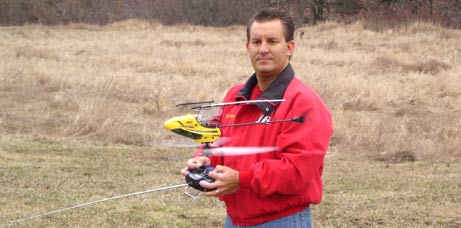 |
| Team JR member Ron Osinski flies the new E-flite Blade CP RTF. Inverted flight is achieved with E-flite's Aerobatic Enhancement Kit (EFLH1168) and a 3-cell 860-1320mAh Li-Po battery pack (EFLB1005 or THP9003SJ). |
Upgrading the Blade CP for inverted flight and aerobatics is quick and easy using E-flite's optional Aerobatic Enhancement Kit and a 3-cell 860-1320mAh Li-Po battery pack, offering an excellent balance of weight, power and duration.
First, remove the flat-bottom main rotor blades, making it much easier to work on the heli. Next, we suggest checking the gear mesh of the stock pinion (10-tooth) and main gear before removing the main motor for future reference. This is the proper gear mesh that you will also want to achieve when installing the new main motor with 9-tooth pinion included with the enhancement kit. Also, be sure to take note of the wire and plug orientation of the main motor power lead in the 4-in-1 control unit-you will want to plug the new motor power lead into the 4-in-1 with the same polarity and orientation to ensure the main motor and main blades spin in the proper direction.
After removing the stock main motor with 10-tooth pinion, install the new main motor with 9-tooth pinion, making sure to set the proper gear mesh before tightening the motor mounting screws. Proper gear mesh is important to prevent damage to the main gear or drag in the drivetrain that could lead to power loss, shortened flight times and excessive motor heat. With the new main motor installed and proper gear mesh set, plug the motor power lead into the 4-in-1 unit, ensuring you install it with the proper orientation and polarity.
With the new main motor installed, now is a good time to also install the main motor heat sink. This heat sink should be a snug fit on the motor can, and is best placed just below the two open slots near the end of the motor. Don't cover these open slots with the heat sink, as they aid in motor cooling. If your heat sink is a loose fit on the motor can and slides up and down with ease, you can remove and pinch it slightly by hand to increase the friction fit. We also suggest the addition of heat sink compound to further improve the effectiveness of the heat sink. This is also a good time to install the tail motor heat sink following the same installation tips. It is easiest to remove the tail motor from its mount first, and then install the heat sink near the middle of the motor can before reinstalling the tail motor in its mount.
With the new main motor and both heat sinks installed, all that's left to do is install the symmetrical main blades and mount the 3-cell Li-Po battery pack. When installing the main blades, they should be tightened so they can pivot in the blade grip when moderate pressure is applied. Never allow the main blades to swing too freely in their grips, as this could cause a boom strike during aggressive flying or aerobatics. Blades that are too tight in the grips may also be difficult to track, so take your time finding just the right amount of pressure.
When mounting the 3-cell Li-Po battery pack, you can slide the battery support plate fore and aft to achieve the proper center of gravity (CG) for the model as outlined in the manual. We suggest the use of hook and loop material, as well as rubber bands for the most secure battery pack mounting.
With all the components installed, along with a fully charged battery pack, follow the 4-in-1 control unit and blade tracking adjustment tips in the manual to ensure you have the tail rotor proportional mix, gyro gain and blade tracking adjusted properly by making a few quick test flights. Typically, only minor adjustments to the proportional trimmer and gyro gain pots will be required when switching from the stock setup to the enhanced setup and 3-cell Li-Po battery pack. (Most often, you will only need to reduce the tail rotor proportional mix and gyro gain slightly.)
Take your time when making adjustments, and the end result will be a smooth and solid performing model capable of a wide variety of aerobatics including loops, rolls, inverted flight and more. For the best overall aerobatic performance, we suggest the use of 3-cell 860-900mAh Li-Po packs with packs up to 1320mAh best used for mild aerobatics and long duration flights.
You can use the throttle trim on the transmitter to finely adjust the throttle and pitch curve of your Blade CP once the 4-in-1 unit has been armed. Increasing the trim will allow for more positive pitch, while decreasing the trim will allow for more negative pitch. Depending on the setup of your particular model, you can achieve an equal amount of positive and negative pitch in the idle-up (stunt/aerobatic) flight mode with the trim near center. You can also better adjust the stick position at which your model hovers in the normal flight mode by also using the throttle trim. Don't forget to lower the throttle trim all the way to arm the 4-in-1 unit first before flight, and to power down the motors after flying. |